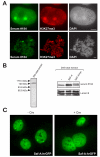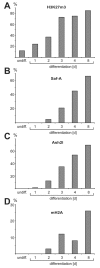The Trithorax group protein Ash2l and Saf-A are recruited to the inactive X chromosome at the onset of stable X inactivation
- PMID: 20150277
- PMCID: PMC2834461
- DOI: 10.1242/dev.035956
The Trithorax group protein Ash2l and Saf-A are recruited to the inactive X chromosome at the onset of stable X inactivation
Abstract
Mammals compensate X chromosome gene dosage between the sexes by silencing of one of the two female X chromosomes. X inactivation is initiated in the early embryo and requires the non-coding Xist RNA, which encompasses the inactive X chromosome (Xi) and triggers its silencing. In differentiated cells, several factors including the histone variant macroH2A and the scaffold attachment factor SAF-A are recruited to the Xi and maintain its repression. Consequently, in female somatic cells the Xi remains stably silenced independently of Xist. Here, we identify the Trithorax group protein Ash2l as a novel component of the Xi. Ash2l is recruited by Xist concomitantly with Saf-A and macroH2A at the transition to Xi maintenance. Recruitment of these factors characterizes a developmental transition point for the chromatin composition of the Xi. Surprisingly, expression of a mutant Xist RNA that does not cause gene repression can trigger recruitment of Ash2l, Saf-A and macroH2A to the X chromosome, and can cause chromosome-wide histone H4 hypoacetylation. This suggests that a chromatin configuration is established on non-genic chromatin on the Xi by Xist to provide a repressive compartment that could be used for maintaining gene silencing. Gene silencing is mechanistically separable from the formation of this repressive compartment and, thus, requires additional pathways. This observation highlights a crucial role for spatial organization of chromatin changes in the maintenance of X inactivation.
Figures






References
-
- Angulo M., Corominas M., Serras F. (2004). Activation and repression activities of ash2 in Drosophila wing imaginal discs. Development 131, 4943-4953 - PubMed
-
- Beard C., Hochedlinger K., Plath K., Wutz A., Jaenisch R. (2006). Efficient method to generate single-copy transgenic mice by site-specific integration in embryonic stem cells. Genesis 44, 23-28 - PubMed
-
- Blewitt M. E., Gendrel A. V., Pang Z., Sparrow D. B., Whitelaw N., Craig J. M., Apedaile A., Hilton D. J., Dunwoodie S. L., Brockdorff N., et al. (2008). SmcHD1, containing a structural-maintenance-of-chromosomes hinge domain, has a critical role in X inactivation. Nat. Genet. 40, 663-669 - PubMed
-
- Brown C. J., Willard H. F. (1994). The human X-inactivation centre is not required for maintenance of X-chromosome inactivation. Nature 368, 154-156 - PubMed
Publication types
MeSH terms
Substances
Grants and funding
LinkOut - more resources
Full Text Sources
Other Literature Sources

